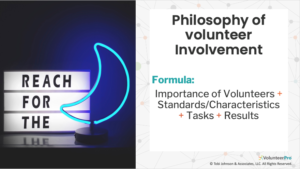Prep for Post-COVID With This Step-by-Step Volunteer Program Evaluation
It seems that the past year has been full of pivots, with nonprofits and nonprofit staff continually reacting to the threat of COVID-19.
And, if you are like many of the other organizations out there, you’ve likely had to significantly reduce volunteer involvement to do your part in keeping your community safe and healthy.
It’s been quite a year for everyone. However, there is good news on the horizon!
As millions get vaccinated, we can start looking toward the future and a new normal.
But how will you know if your nonprofit is prepared and ready to welcome volunteers back?
A volunteer program evaluation can help!
Taking time to assess where you’re at and make changes now, rather than waiting until you are back in full swing makes a lot of sense.
You have time to think, volunteers have time to offer constructive ideas, and you will set yourself up to make the best first impression ever as volunteers return to work.
So, let’s dive into how you can pause, take a breath, and examine your most promising opportunities for the months ahead.
Rate Your Preparedness with this Volunteer Program Evaluation
By conducting a simple self-assessment, you can pinpoint exactly what’s missing from your volunteer program, or what needs revising due to COVID-19 protocols.
Well-designed volunteer programs include a good blend of strategic initiatives, solid human resource practices, and capable leadership.
Want to ensure your volunteer program is primed for success post-COVID?
Read on to find out what tools you need in place to help you build relationships, keep you on mission, and set up a successful volunteer engagement strategy and framework for your organization. Assess what you have on hand (or don’t) at the current moment. What do you need to add? What might you create or improve to make it even better? And, don’t forget to consider what can you let go of that drains your time, but simply isn’t working anymore.
Here are a few key items you will want to have on hand for your big post-COVID re-boot. Check to see if you have these. If so, do they need to be re-worked? Or, do they need to be deployed in a better way?
Philosophy of Volunteer Involvement
This is the absolute foundation of your volunteer program. It describes why volunteers are a strategic human resource for your organization.
It‘s important that the community understand the rationale for volunteer involvement and your regard for volunteer time and talent.
A philosophy of volunteer involvement communicates in no uncertain terms the value of volunteers to an organization.
Note, for a volunteer program to be considered successful the rationale must be beyond merely to save money. After all, volunteers aren’t free! And, while they may expand and deepen the services your organization provides, they may not end up saving your organization money in terms of cutting costs.
Once developed, your philosophy of volunteer involvement can be used in a variety of places and can be tweaked to be used during COVID to relate specifically to how you see volunteers in relationship to the crisis.
If you don’t have one, here’s a simple formula you can follow to write your own:

Volunteer Manager Job Description
Have you reviewed your position description lately? Does it truly reflect everything you do? Is it prioritized in a way that makes sense? Are your key results clear? Is the proper training and support for your role built in?
As a volunteer manager, pulled in many different directions, you want to ensure that a specific and adequate amount of time is allocated for relationship building with all stakeholders. This is especially true when during COVID you need to work overtime to engage your community in new ways.
If you haven’t reviewed your job description in a while, doing so as part of this volunteer program evaluation is crucial.
Bonus: with the pandemic, it’s likely that you’ve taken on added responsibilities. It’s a good time to decide if those responsibilities will stay with you long-term, and if so, how you can negotiate to include a new title and/or salary.
Learn what’s included in a typical volunteer coordinator job description in this VolunteerPro blog post.
Action Plan for Attracting New Volunteers

If you are not thinking of you can attract new volunteers to help you re-boot your volunteer program post-COVID, you are going to miss the boat! If you wait until you have total assurance that all is going to be okay, you will have lost the opportunity to raise awareness for your cause without MASSIVE competition from other organizations.
So, what’s your plan?!
Your plan needs to be strategic and focused on specific audiences that make the most sense for your organization.
You also need to be crystal clear on which volunteer roles are most important to recruit for first and which can wait. And how you will quickly ramp up the training for your team (for both volunteers and co-workers), so they are ready to hit the ground running.
Here’s a 4-step process to get you started:
Step 1: Set your recruitment goals
List out all of your volunteer roles, then think about the number of current volunteers you have in each role, the added number you need in each role, and your capacity goal.
If you don’t know where you need volunteers, you won’t be successful in your efforts to attract new volunteers!
Step 2: Partner with your marketing department
You can’t successfully recruit volunteers without the aid of your marketing department. Set up a meeting with them to work out a monthly content calendar. Think of every touchpoint potential volunteers might come across your agency: blogs, newsletters, social media, etc.
Read more about working with your marketing team in this blog post.
Step 3: Audit your current communications
Review all of your volunteer recruitment channels. Then consider the following:
-
- Do your communications channels represent a good mix, rather than relying on one or two ways to reach potential volunteers?
- Do your communications present a unified brand to your prospective volunteers across channels?
- Do your communications present consistent messages and calls to action to your supporters across channels?
- What needs to change in the short-term (next 90-days) and in the long-term (within the year)?
Step 4: Conduct a competitor SPOT analysis
You will want to have a plan for exploring current competition for volunteer talent so that you can proactively plan to seize emerging opportunities by playing to your strengths.
First, you will want to identify your competitors. Then, you will want to complete a SPOT matrix for each of them, composed of their:
-
- STRENGTHS – Current assets, resources, results, skills, keywords of your competitor
- PROBLEMS – Their current weaknesses, challenges, and gaps of your competitor
- OPPORTUNITIES – Where can you convert your competitor’s problems and threats into solutions that help you meet your goals
- THREATS – Realities or developments in the world of your competitor that could block your success by becoming a problem in the near future
Volunteer Management Software System
What are you using to capture and manage volunteer data efficiently and effectively? How much time are you spending each week on data management? Could your time be better spent on more high-impact tasks?
Volunteer data management can be a huge time commitment, especially when you don’t have software to do the work for you.
The truth is that managing volunteers with excel spreadsheets just doesn’t cut it anymore. You need a software platform that helps you automate redundant tasks, allows volunteers to manage their own profiles and log their hours, and acts as a communications conduit with your supporters. Make finding these kinds of efficiencies a priority when conducting a volunteer program evaluation.
To truly scale, you need to get out from behind your desk, and antiquated systems drag you down. What’s currently stopping you? Use your volunteer program evaluation to assess how the change can be made.
Check out this blog by Tobi for more information on what to look for in volunteer management software.
Volunteer Position Descriptions
Much like your job description, now is a good time to review your organization’s volunteer position descriptions. Do they meet your emerging needs? Are there new requirements that need to be added? Which need to be retired because they no longer contribute to your mission in a meaningful way?
It’s time to be flexible enough to create new roles, based on new interests, availability, requirements, etc…, and focused enough to remove those that no longer work (even if they are your volunteers’ faves!). Yes, this is hard to do, but this is likely the easiest time to take these steps.
Wondering what to include or how to improve how you describe volunteer opportunities? Want some inspiration on how to write captivating volunteer position descriptions that will boost your recruitment? Check out this VolunteerPro blog post for 12 things you must include!
Volunteer Webpage
Most people turn to Google first when they are researching an activity. What shows up when they search for volunteer roles in your community? Where does your organization show up in search results? And how do you think it looks to a newcomer?
Take a moment to check … we’ll wait right here until you get back. :)
So, what did you learn? Is your volunteer webpage easy to find? Do you clearly communicate all the steps in the application process & build trust with visitors? Do you include compelling calls-to-action?
If not, you may be leaving potential volunteer talent on the table.
Review your recruitment page as part of your volunteer program evaluation and ask yourself the following questions:
- Are your current openings listed?
- Is it easy to find from your agency home page?
- Is a compelling case made for the need for your volunteer-led services?
- Is there sufficient information about what volunteering actually entails?
- Is there social proof that others have benefited from the volunteer program (as volunteers and service beneficiaries)?
- Do visitors have a clear picture of what to do next?
If you answered “no” to any of those questions, consider what you need to do to get to “yes” and do it!
Volunteer Application

What about the first form most volunteers fill out? It can make or break the relationship. Have you thought about what it communicates and how it might be perfected?
Ask yourself …
Does your volunteer application gather vital volunteer information? Do you include information that helps volunteers understand that the organization is a safe place? Don’t forget the power of using inclusive language to ensure everyone feels empowered to apply.
Also, make sure your volunteer application is accessible to everyone who wants to apply. Not everyone has access to the internet, so ensure you offer paper copies. You might want to include your contact information so you can aid a visually impaired person who is trying to complete the application.
If used, include background check and personal reference releases with a short explanation as to why they are important.
Volunteer Screening Interview Questions
Your interviews are another vital way to begin to build and deepen relationships with new volunteer prospects. Don’t leave them up to chance or think of them as a pro-forma exercise.
Interviews are a two-way street, you must talk AND listen. And I mean really listen!
This is your first opportunity to learn about the volunteer’s preferences, their motivation for volunteering, and their behavior in certain situations.
What you learn during the interview is going to inform every other interaction you have with a volunteer during their time with your organization.
Here are some questions you should consider asking:
- Tell me about yourself (hobbies, interests, past/present career, etc.). What brings you the most joy?
- What nonprofit causes are close to your heart? Why are these special to you? Why does our cause resonate?
- How did you hear about our program? What appealed to you about our opportunities?
- We hope our volunteers get as much as they give. Is there anything particular you’d like to gain from a volunteer experience here?
- Have you volunteered before? Are you still volunteering? If you left, why did you leave? What did you like about it? What did you dislike?
- Do you have any specific knowledge, skills, or talents you would like to contribute? Is there anything you don’t want to do? Do you prefer working alone or with a group?
- Explain a time when you had to work as a member of a team. What role did you take on and what kind of member were you? Were there any challenges, and if so, how did you handle them?
- What makes you feel appreciated in the workplace and when you volunteer? What drives you crazy?
- When are you hoping to volunteer? How often and when?
- What questions do you have for me or about our organization?
Volunteer Agreement
Now is a great time to review your agreement for new volunteers. It’s important to have a document that marks the day that volunteers transition from interested observer to appointed volunteer.
Why? You might ask.
It’s about risk management, but not in the way you might be thinking. Many organizations view volunteer agreements as a type of waiver, or document that removes the organization from any liability.
What that is true, they also help protect volunteers by marking the time when they become protected by the Volunteer Protection Act (or other “good Samaritan” legislation, if you are outside the US). These laws protect volunteers only when they are authorized to act on behalf of the organization. The volunteer agreement makes that authorization explicit.
This is also where you need to reassure new volunteers that your nonprofit is well run and that their information will be protected.
You should also mention your organization’s privacy policy, confidentiality policy, and any other policies as applicable.
Regarding COVID related policies, procedures, and/or waivers, check out this blog to decide if you should, or should not, write one.
Another way to think about volunteer involvement during this time is to equate it to the employee experience at your organization. All workers, paid and unpaid, should be considered staff at your organization. Consider treating both employees and volunteers the same as you bring them back onsite post-COVID. Are you requiring employees to get vaccinated? If so, should you require your volunteers to do so, too? If your employees are not required to show proof of vaccination status, should volunteers be asked to do so?
It’s an unprecedented time, and these decisions are no doubt difficult. Don’t make them alone, and make sure your agency’s legal counsel is involved in the volunteer program evaluation process and reviews any contracts, agreements, or waivers with volunteers to ensure they are non-discriminatory and as well as legally binding.
Volunteer Manual/Handbook
As nonprofits rely on volunteers more and more every day, a volunteer handbook is needed to help guide them through the orientation process and to learn about the organization’s history and goals.
Your handbook can inspire new volunteers & help them understand social norms and unwritten rules. Also, include a short Acknowledgement Form for them to sign.
But they don’t have to be dry and boring!
Review your existing handbook or manual (if you have one). Is it easy to find quick answers? Is it fun to read? Does it feel supportive and valuable?
Here are some key items you should include:
- A Heartfelt Welcome
- Information About Your Organization & Its History
- Your Philosophy on Volunteerism
- Ethics Guidelines (your policies & procedures)
- Working Conditions
- Required Paperwork and Reporting
- Training
- Perks and Benefits
- Supervision and Support
- Volunteer Feedback
- Additional Resources and Attachments
Keep it as concise and brief as possible. You can even break it with quotes from employees and volunteers.
Also, your volunteer agreement can be a page in the manual. If so, make sure you include in your agreement that volunteers agree to follow the guidelines in the manual and to ask for help when they need it.
Recognition and Retention Strategy
Finally, the key to keeping volunteers happy and engaged is by acknowledging their individual contributions of time and talent on a consistent basis.
How well is your organization doing in this regard? Is it part of everyone’s job, or just yours? Do you wait to do this as a formal group event, once a year? What about informal and individualized expressions of gratitude? Where do they fit in?
Instead of waiting until the last minute to set up a volunteer recognition event, (and if you forgot about National Volunteer Week here in the US, we’ve got you covered!) find ways to integrate volunteer appreciation into your daily nonprofit management practices.
Not sure where to start? Grab our [FREE eBook] Volunteer Appreciation: 50 Simple Ways to Show Your Love and learn how you can inspire volunteers by fostering and calling attention to their internal satisfaction and fulfillment.
Also, don’t forget the power a simple smile, hello, thank you, and/or “good job!” can have!
So, there you have it! A full rundown on how to assess your key program documents and strategies.
Now is the time to do it. If you wait until you’re back in the full swing of things, you’ll likely never get it done. And, your volunteers deserve better, don’t they?








Leave A Comment